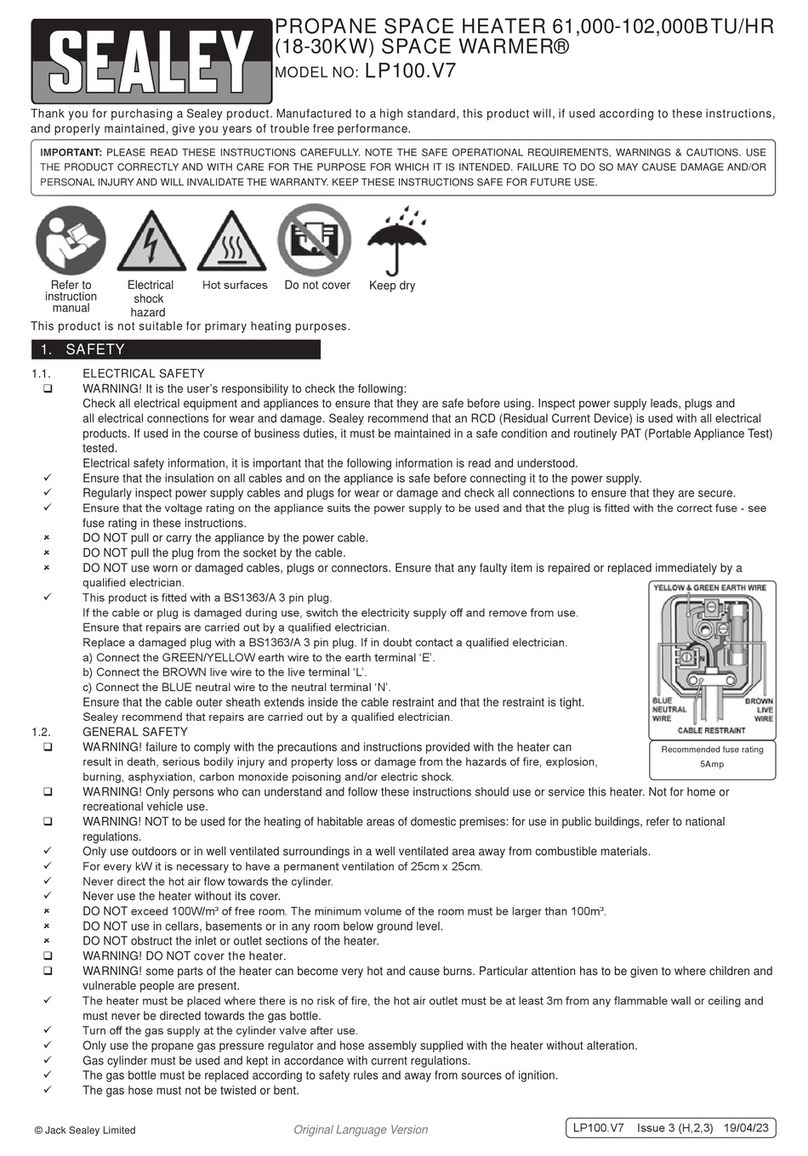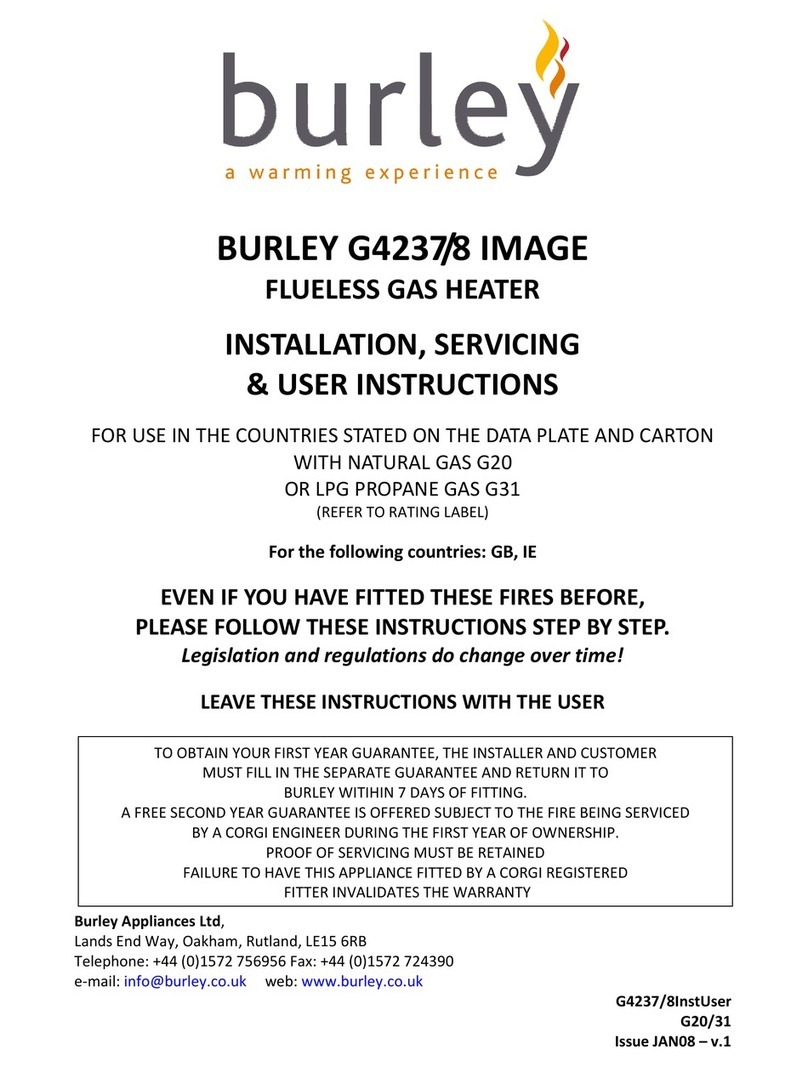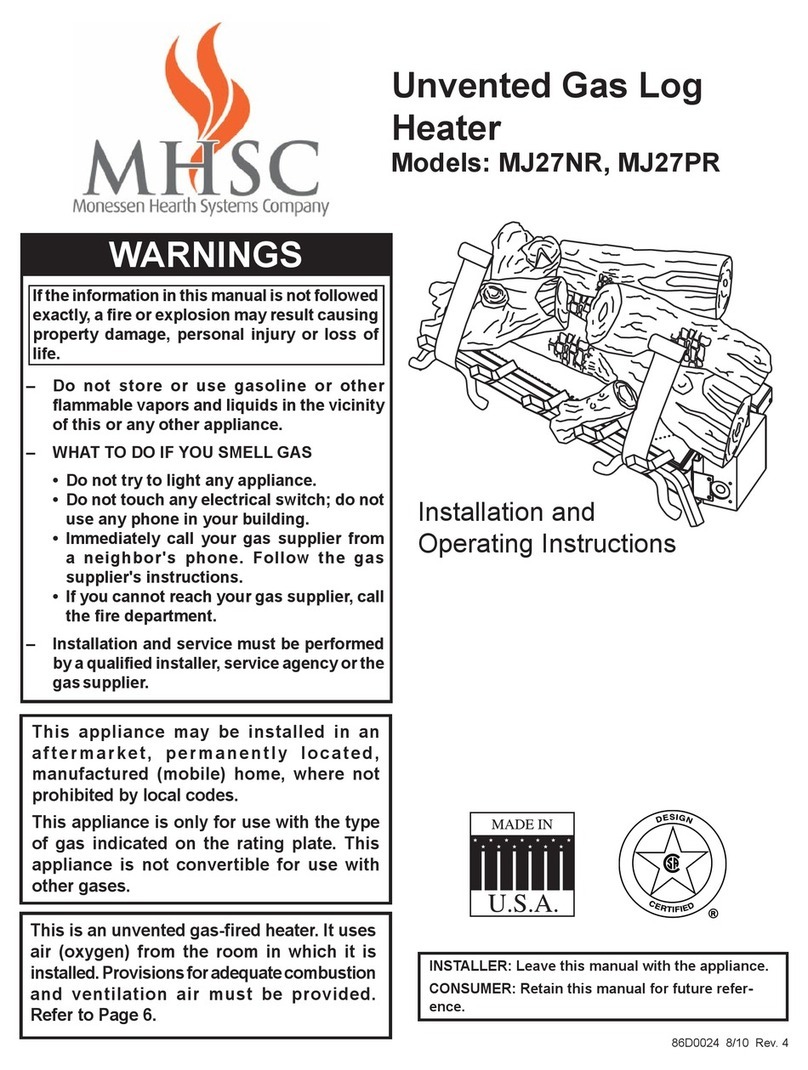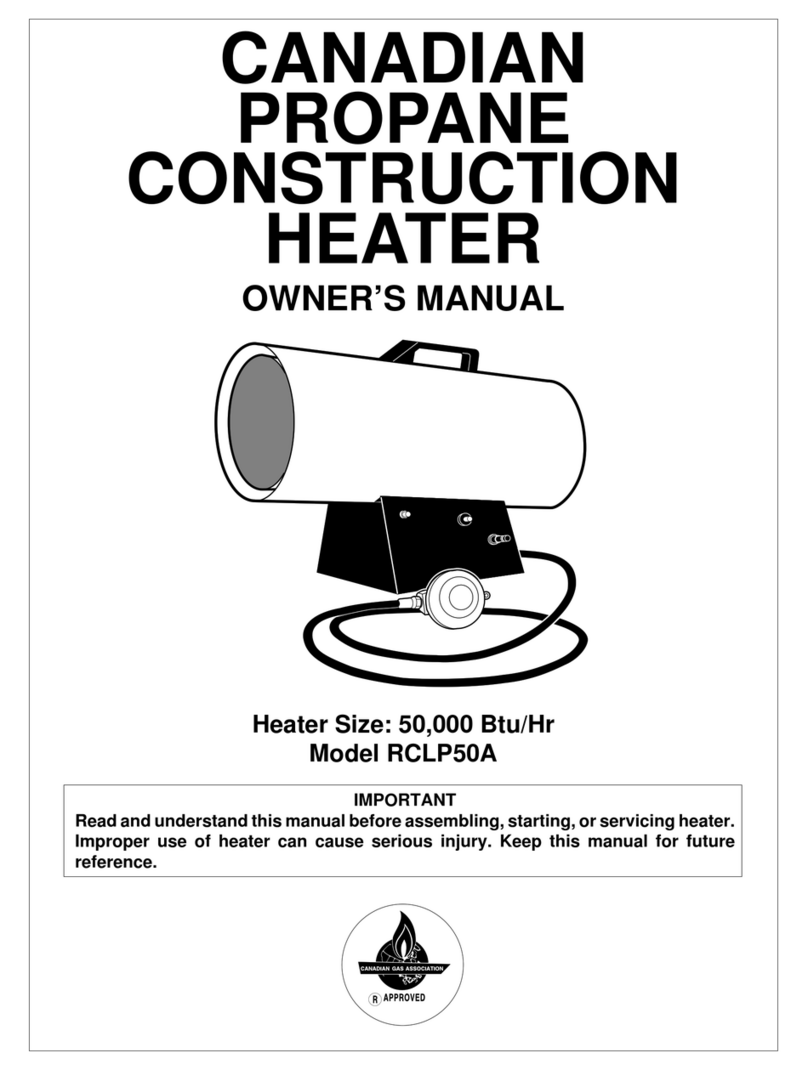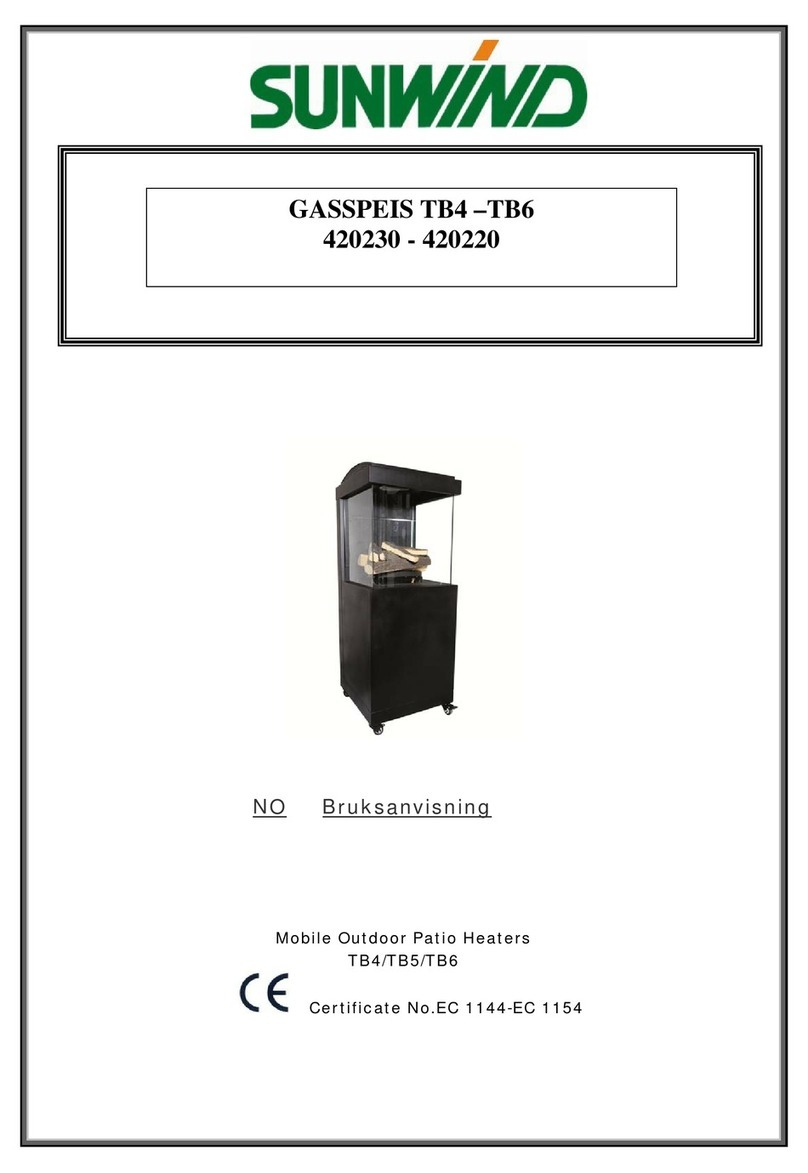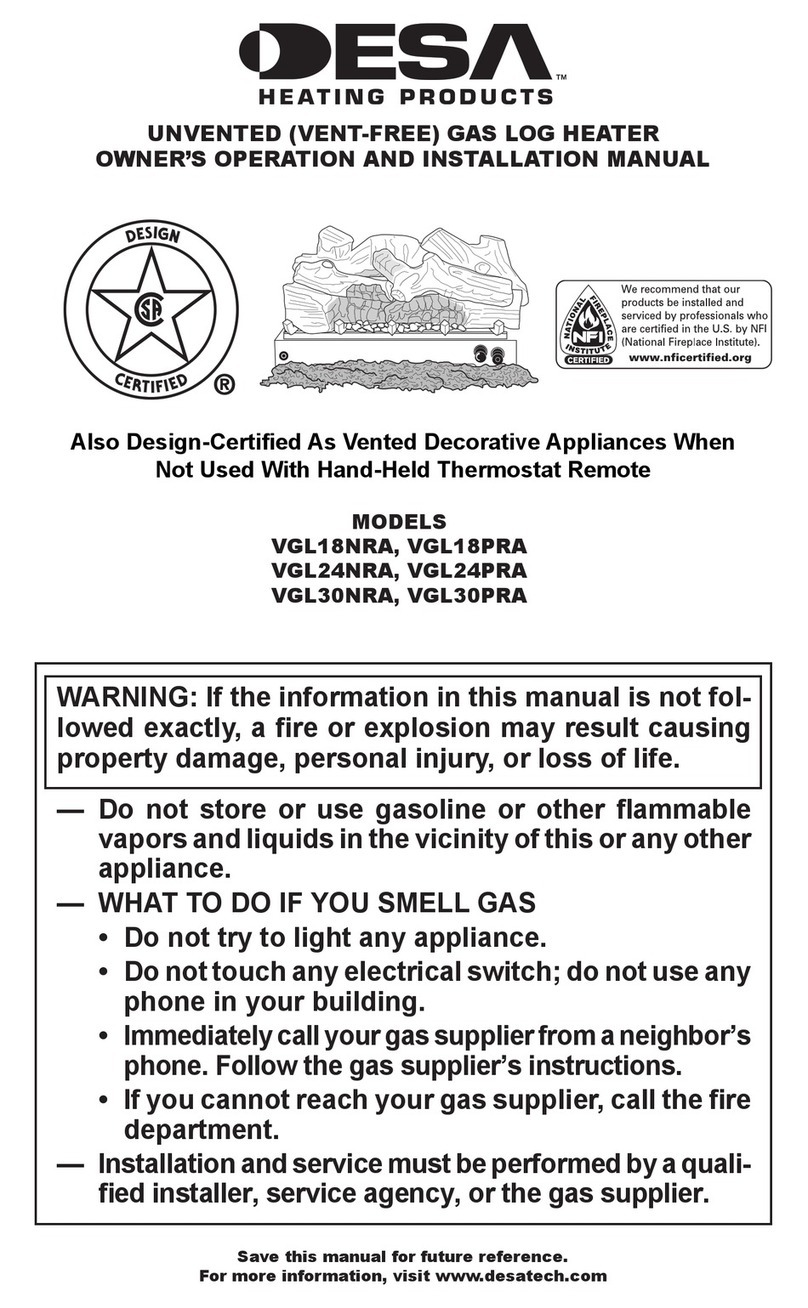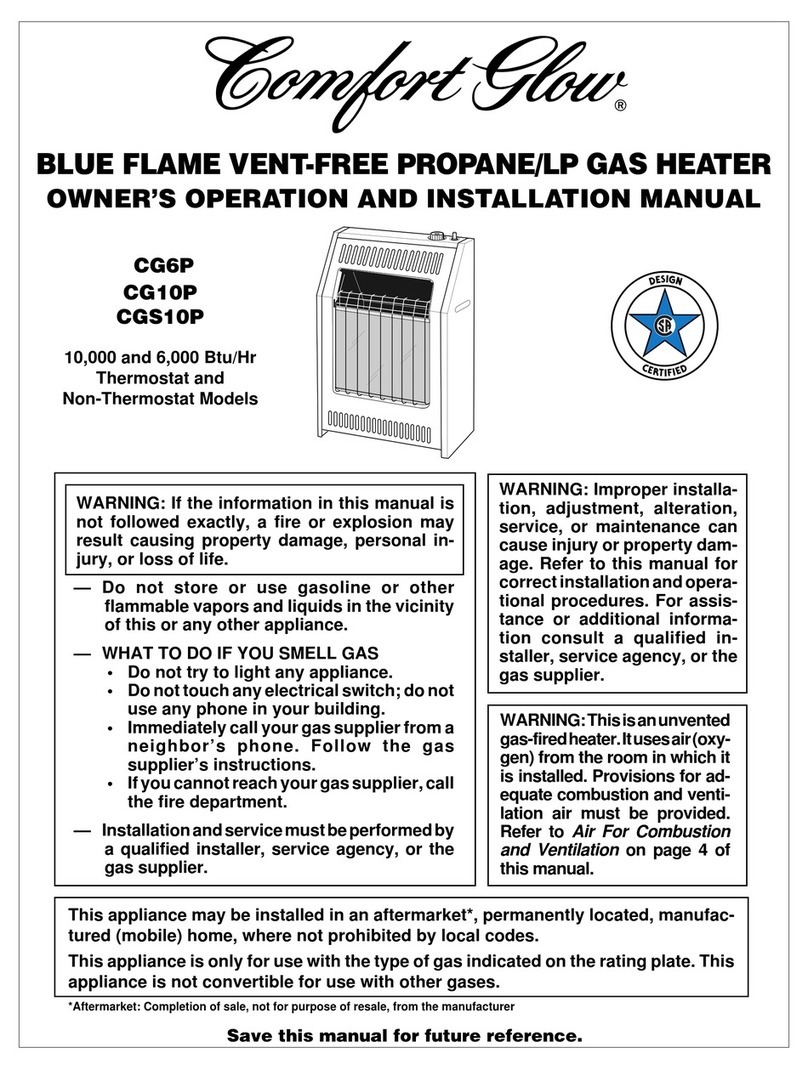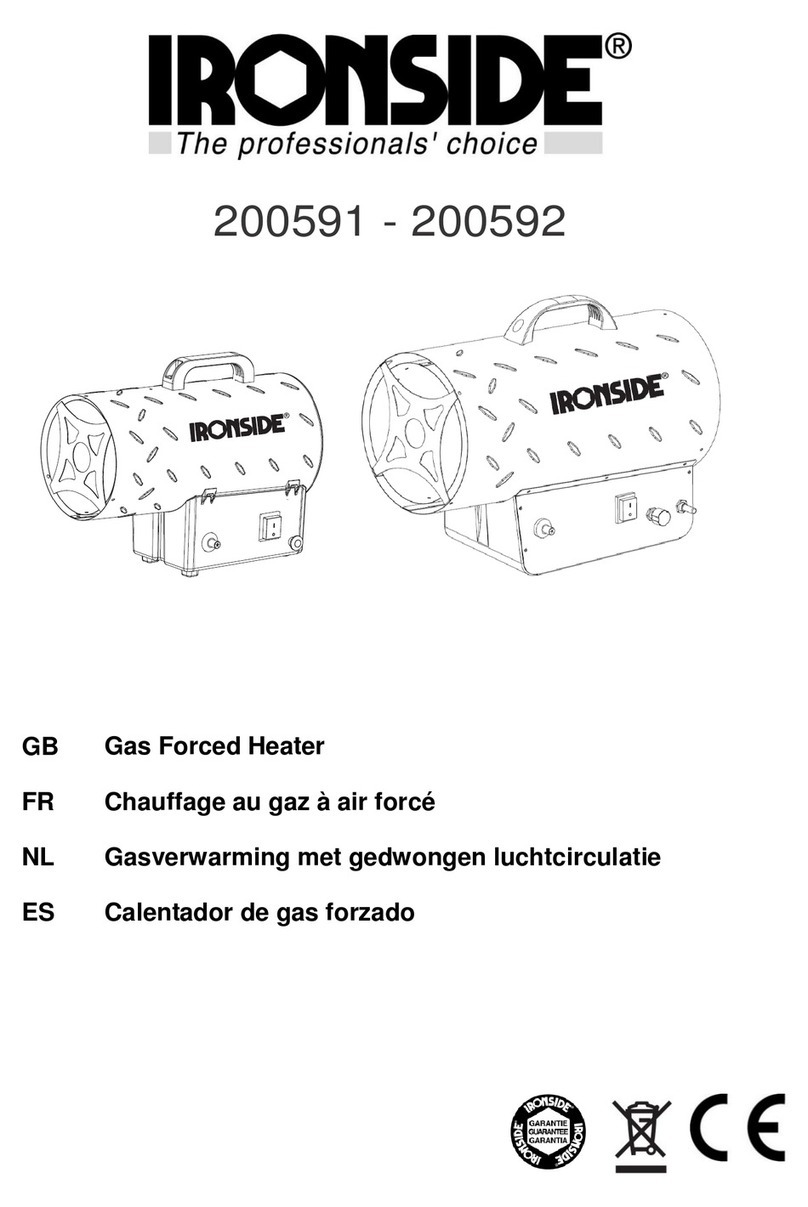HeatStar HSVFBF10LPTS Assembly instructions

1Installation Instructions and Owner’s Manual
Unvented Liquid Propane Fired Room Heater
HEATSTAR, 4560 W. 160TH ST., CLEVELAND, OHIO 44135 · 800-251-0001 2016 - CB
Installer: Leave this manual with the appliance. Consumer: Retain this manual for future reference.
UNVENTED LP-GAS FIRED ROOM HEATER
HSVFBF10LPTS
HSVFRD10LPTS
OPERATING INSTRUCTIONS
AND OWNER’S MANUAL
READ INSTRUCTIONS CAREFULLY: Read and follow all instructions. Place instructions in a safe
place for future reference. Do not allow anyone who has not read these instructions to assemble,
light, adjust or operate the heater.
Model #
WARNING: If the information in this manual is not followed exactly, a fire or explosion may result causing
property damage, personal injury, or loss of life.
- Do not store or use gasoline or other flammable vapors and liquids in the vicinity of this or any other appliance.
- WHAT TO DO IF YOU SMELL GAS
• Shut off gas supply
• Do not try to light any appliance
• Do not touch an electrical switch; do not use any phone in your building.
• Immediately call your gas supplier from a neighbor’s phone. Follow the gas supplier’s instructions.
• If you cannot reach your gas supplier, call the fire department.
- Installation and service must be performed by a qualified installer, service agency, or the gas supplier.
WARNING: This is an unvented gas-fired heater. It uses air (oxygen) from the room in which it is installed.
Provisions for adequate combustion and ventilation air must be provided. Refer to Fresh Air for Combustion and
Ventilation section on page 4 of this manual.
WARNING: Improper installation, adjustment, alteration, service or maintenance can cause injury or property
damage. Refer to this manual for correct installation and operational procedures. For assistance or additional
information consult a qualified installer, service agency, or gas supplier.
This appliance may be installed in an aftermarket permanently manufactured (mobile) home, where not prohibited
by local codes. This appliance is only for use with the type of gas indicated on the rating plate. This appliance is not
convertible for use with any other gas.
Blue Flame Heaters
HSVFBF10LPTS
Plaque Heaters
HSVFRD10LPTS

2Installation Instructions and Owner’s Manual
Unvented Liquid Propane Fired Room Heater
CONTENTS
WARNINGS........................................................................2
SPECIFICATIONS.................................................................3
PRECAUTIONS....................................................................3
THERMOSTATIC CONTROL .................................................4
DETERMINING THE TYPE OF HEATER LOCATION SPACE .....4
INSTALLATION ...................................................................5
FASTENING HEATER TO WALL............................................6
FLOOR MOUNTING AWAY FROM WALL .............................8
CONNECTING TO GAS SUPPLY...........................................8
OPERATING YOUR HEATER............................................... 10
CLEANING AND MAINTENANCE.......................................11
TROUBLESHOOTING ........................................................ 12
PARTS LIST AND DIAGRAM................................................1
WARRANTY .................................................................... 16
CAUTION: Never connect heater directly to the
Propane supply. This heater requires an external
regulator (not supplied). Install the external
regulator between the heater and Propane/LP
supply.
The installer must supply an external regulator.
The external regulator will reduce the incoming
gas pressure to between 11 and 14 inches
of water. If you do not reduce incoming gas
pressure heater regulator damage could occur.
Install external regulator with the vent pointing
down. Pointing the vent down protects it from
freezing rain or sleet.
WARNINGS
IMPORTANT: Read this owner’s manual carefully and completely before trying to assemble, operate, or
service this heater. Improper use of this heater can cause serious injury or death from burns, fire, explosion,
electrical shock, and carbon monoxide poisoning.
WARNING: This appliance is equipped for propane
gas. Field conversion is not permitted.
WARNING: Do not use any accessory not
approved for use with this heater.
WARNING: Any change to this heater or its
controls can be dangerous.
• Do not place clothing or other flammable ma-
terial on or near the appliance.
• Due to high temperatures, heater should be
kept out of traffic and away from furniture and
draperies.
• Surface of heater becomes very hot when
running. Keep children and adults away
from hot surfaces to avoid burns or clothing
ignition. Heater will remain hot for a time
after shutdown. Allow heater surfaces to cool
before handling.
• Young children should be carefully supervised
when they are in the same room with heater.
• Make sure grille guard is in place before
running heater. If screen or grille guard is
removed for servicing it must be replaced prior
to operating the heater.
• Keep the appliance area clear and free from
combustible materials, gasoline, and other
flammable vapors and liquids.
• Children and adults should be alerted to the
hazard of high surface temperature and should
stay away to avoid burns or clothing ignition.
• Any safety screen or guard removed for
servicing an appliance must be replaced prior
to operating the heater
SOCIAL MEDIA
In order to provide the best service possible Mr. Heater is now giving you
more ways to get in touch with us:
WEBSITE: Mr. HeaterÊs full line of product are now at:
WWW.MRHEATER.COM
FACEBOOK: Find us on Facebook
TWITTER: Find us on twitter
YouTube: There are now informational videos on YouTube.

3Installation Instructions and Owner’s Manual
Unvented Liquid Propane Fired Room Heater
DANGER: Carbon monoxide poisoning may lead to
death.
Carbon Monoxide Poisoning:
Early signs of carbon monoxide poisoning resemble
the flu, with headaches, dizziness, or nausea. If you
have these signs, the heater may not be working
properly. Get fresh air at once! Have heater serviced.
Some people are more affected by carbon monoxide
than others. These include pregnant women, persons
with heart or lung disease or anemia, those under the
influence of alcohol, and those at high altitudes.
Propane/LP Gas:
Propoane/LP gas is odorless.An odor making agent is
added to propane/LP gas. The odor helps you detect
a Propane/LP gas leak. However the odor added to
propane/LP gas may be present even though no odor
exists. Make certain you read and understand all
warnings. Keep this manual for reference. It is your
guide to safe and proper operation of this heater.
Product Features
Figure 1
PRECAUTIONS:
1. 10,000 BTU may be installed in a bedroom, but not
a bathroom, or any place where a strong wind would
shut down the appliance.
2. This heater needs outside ventilation air to run
properly. The Oxygen Depletion Sensor (ODS) safety
shutoff system shuts down the heater if not enough
fresh air is available. See Fresh Air for Combustion
and Ventilation, page 5.
3. Keep all air openings in heater clear, free of debris
or any blockage. This will insure that enough air for
proper combustion enters the heater.
4. If heater shuts off, do not relight until you provide
fresh, outside air. If heater keeps shutting off, it
requires servicing.
5. Turn off and let cool before servicing. Only a qualified
service person should service and repair heater.
6. Do not run heater:
• Where flammable liquids or vapors are used or stored
• During dusty conditions.
7. Before using furniture polish, wax, carpet cleaner or
similar products, turn heater off. If heated the vapors
from these products may create a white powder
residue within burner box or on adjacent walls or
furniture.
8. Do not use heater if any part has been underwater.
Immediately call a qualified service technician to
inspect the room heater and to replace any part of
the control system and any gas control which has
been underwater.
9. Operating heater above elevations of 4,500 feet
could cause pilot/ODS to shutdown heater.
10. Always run heater with control knob in a locked
position. Never set control knob between locked
positions. Poor combustion and higher levels of
carbon monoxide may result if control knob is left
between locked positions.
Control Knob
Grill
Front Panel
Burners
Heater
Cabinet
**Operating heater above elevations of 4,500 feet could cause pilot/ODS to shutdown heater.**
SPECIFICATIONS
MODEL HSVFRD10LPTS HSVFBF10LPTS
BTU (Available) 10,000 10,000
Type of Gas LP-Gas Only LP-Gas Only
Ignition Electronic Pulse (AA Battery) Electronic Pulse (AA Battery)
Pressure Regulator Setting 10 Inches of Water 10 Inches of Water
Inlet Gas Pressure (Maximum) 14 Inches of Water 14 Inches of Water
Inlet Gas Pressure (Minimum) 11 Inches of Water 11 Inches of Water
Burners / Orifice nozzles 2 1
Thermostatic Control Yes Yes
Clearances: inches (mm)
Top 36” (915cm) 36” (915cm)
Sides 10” (254cm) 10” (254cm)
Floor (min. to top of carpet) 3” (76cm) 3” (76cm)
Fabric / flammable objects 36” (915cm) 36” (915cm)36” (915cm)

4Installation Instructions and Owner’s Manual
Unvented Liquid Propane Fired Room Heater
atmosphere have a continuous water vapor retarder
with a rating of one perm (6 x 10-11 kg per pa-sec-m2)
or less with openings gasketed or sealed and
b. Whether stripping has been added on operable
windows and doors, and
c. Caulking or sealants are applied to areas such
as joints around windows and door frames,
between wall-ceiling joints, between wall panels, at
penetrations for plumbing, electrical, and gas lines,
and at other openings.
If you home does not meet all of the three criteria
above, see Determing the Type of Heater Location
Space, below.
Confined Space and Unconfined Space
The National Fuel Gas Code, NFPA 54/ ANSI Z223.1
defines a confined space as a space whose volume is
less than 50 cubic feet per 1,000 Btu per hour (4.8 m3
per kW) of the aggregate input rating of all appliances
installed in that space, and an unconfined space as a
space whose volume is not less than 50 cubic feet per
1,000 Btu per hour (4.8 m3per kW) of the aggregate
input rating of all appliances installed in that space.
Rooms communicating directly with the space in which
the appliances are installed*, through openings not
furnished with doors, are considered a part of the
unconfined space.
*Adjoining rooms are communication only if there
are odorless passageways or ventilation grills
between them.
DETERMINING THE TYPE OF HEATER
LOCATION SPACE:
Use this method to determine if you have a confined or
unconfined space.
Note: the space includes the room in which
you install heater plus any adjoining rooms with
doorless passageways or ventilation grills between
the rooms.
1. Find the volume of the space by multiplying room
length x width x height.
Example: Space size 18ft (length) x 18ft. (width) x 8ft.
(height) = 2592
If additional ventilation to adjoining room is supplied
with grills or openings, add the volume of these rooms
to the total volume of the space.
2. Divide the space volume by 50 cubic feet to
determine the maximum Btu/hr the space can
support.
Example: 2592 cu.ft. (volume of space) / 50 cu.ft. =
51.8 or 51,800 (maximum Btu/hr the space
can support)
WARNING: If the area in which the heater may be
operated is smaller than defined as an unconfined
space or if the building is of unusually tight
construction, provide adequate combustion and
ventilation air by the methods described in the
National Fuel Gas Code, NFPA 54/ ANSI Z223.1,
Section 5.3 or applicable local codes.
SAFETY DEVICE
This heater has a pilot with an Oxygen Depletion
Sensor (ODS) safety shut off system. The ODS/pilot
shuts off the heater if there is not enough fresh air.
IGNITION SYSTEM
PIEZO: The heater is equipped with an electronic
manual ignitor. This system requires no matches, or
other source to light heater, but does require one AA
battery to operate ignitor. (AA Battery included).
THERMOSTATIC CONTROL
These heaters have a control valve with a thermostat
sensing bulb. This results in the greatest heater comfort
and may reult in lower fuel bills.
LOCAL CODES
Install and use heater with care.
Installation must conform to local codes or in the
absences of local codes, use the latest edition of
National Fuel Gas Code ANSI Z223.1/NFPA 54.
UNPACKING
1. Remove heater from carton.
2. Remove all protective packaging applied to
heater for shipment.
3. Check heater for any shipping damage. If
heater is damaged, promptly inform dealer
where you bought heater.
FRESH AIR FOR COMBUSTION AND
VENTILATION
WARNING: This heater shall not be installed in
a confined space or unusually tight construction
unless provisions are provided for adequate
combustion and ventilation air. Read the following
instructions to insure proper fresh air for this and
other fuel-burning appliances in your home.
ESTABLISHING ADEQUATE VENTILATION
The following are excerpts from National Fuel Gas
Code, NFPA 54/ ANSI Z223.1, Section 5.3, Air for
Combustion and Ventilation. All spaces in homes fall
into one of the three following ventilation classifications:
1. Unusually Tight Construction
2. Unconfined Space
3. Confined Space
This heater must not be installed in a confined space
or unusually tight construction unless provisions are
provided for adequate combustion and ventilation air.
The information on pages 3 through 5 will help you
classify your space and provide adequate ventilation.
Unusually Tight Construction
If your home meets all of the three following criteria you
must provide additional fresh air. See Ventilation Air
from Outdoors, page 5.
Unusually tight construction is defined as construction
where:
a. Walls and ceilings exposed to the outside

5Installation Instructions and Owner’s Manual
Unvented Liquid Propane Fired Room Heater
outdoors or spaces open to the outdoors. These
include attics* and crawl spaces. Follow the National
Fuel Gas Code NFPA 54/ANSI Z223.1, Section 5.3,
Air for Combustion and Ventilation for required size of
ventilation grills or ducts.
*IMPORTANT: Do not provide openings for inlet or
outlet into attic. If attic has a thermostat-controlled
power vent, heated air entering the attic will activate
the power vent.
IMPORTANT: Vent-free heaters add moisture to
the air. Although this is beneficial, installing heater
in rooms without enough ventilation air may cause
mildew to form from too much moisture. See Fresh
Air for Combustion and Ventilation, pages 3
through 5.
INSTALLATION
NOTICE: This heater is intended for the use as
supplemental heat. Use this heater along with your
primary heating system. Do not install this heater as
your primary heat source. If you have a central heating
system, you may run system’s circulating blower while
using heater. This will help circulate the heat throughout
the house. In the event of a power outage, you can use
this heater as your primary heat source for the duration
of the outage.
3. Add the Btu/hr of all the fuel-burning appliances
in the space such as, Vent–free heater, Gas water
heater, Gas furnace, Vented gas heater, Gas
fireplace logs, and Other gas appliances*
*Do not include direct-vent gas appliances. Direct-
vent draws combustion air from the outdoors and
vents to the outdoors.
Example:
Gas water heater 40,000 Btu/hr
Vent Free Heater + 20,000 Btu/hr
Total =60,000 Btu/hr
4. Compare the maximum Btu/hr the space can support
with the actual amount of Btu/hr used.
Example: 51,800 Btu/hr (maximum Btu/hr the
space can support)
60,000Btu/hr(Actual amount ofBtu/hrused)
The space in the above example is a confined
space because the actual Btu/hr used is more than
the maximum Btu/hr the space can support.
You must provide additional fresh air. Your options
are as follows:
A. Rework worksheet, and the space of an adjoining
room. If the extra space provides an unconfined
space, remove door to adjoining room or add
ventilation grills between the rooms. See Ventilation
Air From Inside Building (Fig. 2)
B. Vent room directly to the outdoors. See Ventilation
Air From Outdoors (Fig. 3).
C.Install a lower Btu/hr heater if lower Btu/hr size
makes room unconfined.
If actual Btu/hr used is less than the maximum
Btu/hr the space can support, the space is an
unconfined space. You will need no additional fresh
air ventilation.
VENTILATION AIR
Ventilation from Inside Building
This fresh air would come from an adjoining unconfined
space. When ventilation to an adjoining unconfined
space, you must provide two permanent openings: one
within 12” of the ceiling and one within 12” of the floor
on the wall connecting the two spaces (see options
1 & 2 of figure 2). You can also remove door into
adjoining room (see option3, fig 2). Follow the National
Fuel Gas Code NFPA 54/ANSI Z223.1, Section 5.3,
Air for Combustion and Ventilation for required size of
ventilation grills or ducts.
WARNING: Rework worksheet, adding the space
of the adjoining unconfined space. The combined
space must have enough fresh air to supply all
appliance in both spaces.
Ventilation from Outdoors
If necessary provide extra fresh air by using ventilation
grills or ducts. Connect these items directly to the
Ventilation
Gills into
Adjoining
Room - Op-
tion 1
Ventilation Gills into Ad-
joining Room - Option 2
12”
12”
Or remove
door into
Adjoining
Room -
Option 3
INLET
AIR
OUTLET
AIR
VENTILATION CRAWL SPACE
TO CRAWL
SPACE
TO ATTIC
VENTILATION AIR
VENTILATED
ATTIC
OUTLET AIR
Figure 2
Figure 3.

6Installation Instructions and Owner’s Manual
Unvented Liquid Propane Fired Room Heater
WARNING: A qualified service person must install
heater. Follow all local codes.
CHECK GAS TYPE
Use only LP-gas. If your gas supply is not LP-gas, do
not install heater. Call dealer where you bought heater
for proper type heater.
THIS INSTALLATION REQUIRES:
Before installing heater, make sure you have the items
listed below:
• Piping (check local codes)
• Sealant (resistant to LP_Gas)
• Equipment shutoff valve*
• Ground joint union
• Test gauge connection*
• Sediment trap
• Tee joint
• Pipe wrench
*A CSA/AGA certified equipment shutoff valve with
1/8” NPT tap is an acceptable alternative to test gauge
connection. Purchase a CSA/AGA certified equipment
shutoff valve from your dealer.
LOCATING HEATER
This heater is designed to be mounted on the wall. The
heater can also be located on a non-combustible floor,
away from a wall by using the floor mounting stands
included with the heater. If installed on combustible
flooring such as carpeting, tile or other combustible
material other than wood flooring, the heater must be
placed on a wood panel the full width and depth of the
appliance.
For convenience and efficiency, install the heater:
• Where there is easy access for operation,
inspection, and service.
• In the coldest part of the room.
CAUTION: If you install the heater in a home garage:
• Heater pilot and burner must be at least 18
inches above floor.
• Locateheater wheremovingvehicle will nothitit.
CAUTION:Thisheatercreateswarm air currents.These
currents move heat to wall surfaces next to heater.
Installing heater next to vinyl or cloth wall covering or
operating heater where impurities (such as tobacco
smoke,aromaticcandles, cleaning fluids,oilorkerosene
lamps, etc.) are present in the air may discolor walls.
WARNING: Never install the heater:
• In a recreational vehicle.
• Where curtains, furniture, clothing, or other
flammable objects are less than 36 inches from
the front, top, or sides of the heater.
• As a fireplace insert
• In high-traffic areas
• In windy or drafty areas
WARNING: Heater must be mounted to maintain
the minimum clearances shown in Figure 4. If
possible, provide greater clearances from the floor,
ceiling, and joining walls.
FASTENING HEATER TO WALL
Mounting Bracket
The mounting bracket in located on the back panel
of heater (see figure 5). It has been taped there for
shipping. Remove mounting bracket from back panel.
Figure 5
Removing Front Panel of Heater
1. Remove (4) screws total there are (2) screws
on either side of the heater (Figure 6)
2. Pull the front panel and back panel apart.
Attaching Mounting Bracket to Wall
Use holes on each end of mounting bracket to attach
bracket to wall. These holes are 16 inches apart.Attach
mounting bracket to wall in one of two following ways.
1. Attach to wall studs
2. Attach to wall anchor
Mounting
Bracket
Left
Side Right
Side
36” (915cm)
min. from ceiling
3” (7.62cm) min. to top surface
of carpet, tile or other combustible
material
Floor
10”(254cm)
from sides
Figure 4

7Installation Instructions and Owner’s Manual
Unvented Liquid Propane Fired Room Heater
Figure 6
Attaching to Wall Stud:
This way is the best providing the strongest mounting in
wood frame houses.
Attaching to Wall Anchor:
This way allows you to attach mounting bracket to
hollow walls (wall areas between studs) or to solid walls
(concrete or masonry).
Decide which way best suits your needs. Either method
will provide a secure hold for the mounting bracket.
1. Tape mounting bracket to wall where heater
will be located. Make sure mounting bracket is
level. For wall stud mounting locate one end of
the mounting bracket over a wall stud.
WARNING: Maintain minimum clearances
shown in figure 7. If you can, provide greater
clearances from the floor and joining wall.
2. Mark screw locations on wall (see figure 7).
3. Remove tape and mount bracket from wall.
Figure 7
Attaching to Wall Stud:
For attaching mounting bracket to wall studs
1. Drill holes at marked locations using 9/64” drill
bit.
2. Place mounting bracket onto wall. Line up
holes on each end of bracket with hole drilled in
wall.
3. Insert mounting screws through bracket and
into wall studs.
4. Tighten screws until mounting bracket is firmly
fastened to wall studs.
Attaching to Wall using Anchor:
For attaching mounting bracket to hollow walls (wall
areas between studs) or solid walls (concrete or
masonry)
Note: Wall anchors, mounting screws, and spacer
are in hardware package. The hardware package is
provided with heater.
1. Drill holes at marked locations using 5/16” drill
bit. For solid walls (concrete or masonry), drill
at least 1” deep.
2. Fold wall anchor as shown in figure 8 below.
Figure 8.
3. Insert wall anchor (wings first) into hole. Tap
anchor flush to wall.
4. For thin walls (1/2” or less) insert red key into
wall anchor.
5. Place mounting bracket onto wall. Line up
holes on each end of bracket with wall anchors.
6. Insert mounting screws through bracket and
into wall anchors.
7. Tighten screws until mounting bracket is firmly
fastened to wall.
Placing Heater on Mounting Bracket
1. Locate two horizontal slots on back pane of
heater (see figure 9).
2. Place heater onto mounting bracket. Slide
horizontal slots onto stand-out tabs on
mounting bracket.
Figure 9
Installing Bottom Mounting Screws
1. Locate two bottom mounting holes. These
holes are near bottom on back panel of heater
(see figure 10).
Adjoining Wall
18” Min.
See clearance
specs on Pg 3
16” (Lg)
12-9/64” (Sm)
Mark mounting hole locations
and drill holes where indicated.
Allow for minimum clearances
Horizontal Slots
Mounting Bracket
mounted to wall
(2) Screws
(2) Screws

8Installation Instructions and Owner’s Manual
Unvented Liquid Propane Fired Room Heater
Figure 10
2. Mark screws locations on wall.
3. Remove heater from mounting bracket.
4. If installing bottom mounting screw into hollow
or solid wall, install wall anchors. Follow steps 1
through 4 under Attaching to Wall using Anchor.
If installing bottom mounting screw into wall
stud, drill holes at marked locations using 9/64”
drill bit.
5. Re-place heater onto mounting bracket.
6. Place spacers between bottom mounting holes
and wall anchor or drilled hole.
7. Hold spacer in place with one hand. With the
other hand, insert mounting screw through
bottom mounting hole and spacer. Place tip of
screw in opening of wall anchor or drilled hole.
8. Tighten both screws until heater is firmly se-
cured to wall. Do not over tighten.
Note: Do not re-place front panel at this time. Re-
place front panel after making gas connections and
checking for leaks.
CONNECTING TO GAS SUPPLY
WARNING: A qualified service person must connect
heater to gas supply. Follow all local codes.
WARNING: This appliance requires a 3/8” NPT
(National Pipe Thread) inlet connection to the
pressure regulator. Use of floor mounting feet will
require you to use a 3/8 NPT street elbow to make
gas connection.
CAUTION: Never connect heater directly to the
Propane supply. This heater requires an external
regulator.(which is attached to the supplied hose).
Install the external regulator between the heater and
Propane/LP supply.
The external regulator will reduce the incoming gas
pressure to between 11 and 14 inches of water. If
you do not reduce incoming gas pressure heater
regulator damage could occur. Install external
regulator with the vent pointing down. Pointing the
vent down protects it from freezing rain or sleet.
CAUTION: Use only new black iron or steel pipe.
Internally-tinned copper tubing may be used in certain
areas. Check your local codes. Use pipe of larger
enough diameter to allow proper gas volume to heater.
If pipe is too small, undue loss of pressure will occur.
Installation must include an equipment shutoff valve,
union and plugged 1/8” NPT tap. Locate NPT tap within
reach of test gauge hookup. NPT tap must be upstream
from heater (see figure 11).
*A CSA/AGA certified equipment shutoff valve with
1/8” NPT tap is an acceptable alternative to test gauge
connection. Purchase the CSA/AGA certified equipment
shutoff valve from your dealer.
IMPORTANT: Install an equipment shutoff valve in an
accessible location. The equipment shutoff valve is for
turning on or shutting off the gas to the appliance.
Apply pipe joint sealant lightly to male threads. This will
prevent excess sealant from going into pipe. Excess
sealant in pipe could result in clogged heater fuel train.
CAUTION: Use pipe joint sealant that is resistant to
LP-Gas.
Install sediment trap in supply line as shown in figure
11. Locate sediment trap where it is within reach
for cleaning. Asediment trap traps moisture and
contaminants. This keeps them from going into heater.
If sediment trap is not installed or is installed improperly,
heater may not run correctly.
IMPORTANT: Hold pressure regulator with wrench
when connecting it to gas piping and/or fittings.
CHECKING GAS CONNECTIONS
WARNING: Test all gas piping and connections for
leaks after installing or servicing. Correct all leaks
at once.
WARNING: Never use an open flame to check for
a gas leak. Apply a mixture of liquid soap and water
to all joints. Bubbles forming show a leak. Correct
all leaks at once.
PRESSURE TESTING GAS SUPPLY PIPING
SYSTEM
High Pressure
Test pressure in Excess of ½ psig (3.5kPa)
1. Disconnect appliance with its appliance main
gas valve (control valve) and equipment shutoff
valve from gas supply piping system. Pressures
in excess of ½ psig will damage heater
regulator.
2. Cap off open end of gas pipe where equipment
shutoff valve was connected.
3. Pressurize supply piping system by either using
compressed air or opening main gas valve on
or near gas meter.
4. Check all connections and joints in gas supply
piping system. Apply mixture of liquid soap and
water to gas joints. Bubbles forming show a
leak.
5. Correct all leaks at once.
6. Depressurize and relieve pressure in supply
piping system.
7. Reconnect heater and equipment shutoff valve
to gas supply.
8. Reconnected fittings must be checked for leaks
in next section.
Screw
hole
Screw
hole

9Installation Instructions and Owner’s Manual
Unvented Liquid Propane Fired Room Heater
Figure 11
Low Pressure
Test Pressure Equal To or Less Than ½ psig (3.5 kPa)
1. Close equipment shutoff valve (see figure 12).
2. Pressurize supply piping system by either using
compressed air or opening propane/LP supply
valve.
3. Check all joints from the propane/LP supply
valve to equipment shutoff valve (see figure
13). Apply mixture of liquid soap and water to
gas joints. Bubbles forming show a leak.
4. Correct all leaks at once.
5. Depressurize and relieve pressure from supply
piping system.
Pressure Testing Heater Gas Connections:
1. Make sure that the heater supply piping sys-
tem is connected and has been leak tested as
described above.
2. Make sure control knob of heater is in OFF
position.
3. Open equipment shutoff valve (see figure 12).
4. Open propane/LP supply valve.
5. Check all joints from equipment shutoff valve
to control valve (see figure 13). Apply mixture
of liquid soap and water to gas joints. Bubbles
forming show a leak.
6. Correct all leaks at once.
7. Light heater (see Operating Your Heater, page 10.
8. Turn off heater (see To Turn OFF Gas to
Appliance, page 10.
9. Replace lower front panel.
OPERATING YOUR HEATER
FOR YOUR SAFETY READ BEFORE LIGHTING
WARNING: If you do not follow these instructions
exactly, a fire or explosion may result causing
property damage, personal injury or loss of life.
A. This appliance has a pilot that must be lighted
by hand. When lighting the pilot, follow these
instructions exactly.
B. BEFORE LIGHTING smell all around the
appliance area for gas. Be sure to smell next to
the floor because some gas is heavier than air
and will settle on the floor.
WHAT TO DO IF YOU SMELL GAS
• Do not try to light any appliance.
• Do not touch any electrical switch; do not use
any phone in your building.
• Immediately call you gas supplier from a
neighbor’s phone. Follow the gas supplier’s
instructions.
Figure 12
• If you can not reach your gas supplier, call the
fire department.
• Use only your hand to push in or turn the gas
control knob. Never use tools. If knob will not
push in or turn by hand, don’t try to repair it; call
a qualified service technician or gas supplier.
Force or attempted repair may result in a fire or
explosion.
Figure 13
Equipment
Shutoff Valve
Open
Closed
Pressure
Regulator
Heater
Cabinet
Ground Joint Union
Equipment
Shutoff Valve
From LP tank
(11” W.C. to 14”
W.C. Pressure)
Tee Joint
1/8” NPT Plug Tap
Cap
Pipe Nipple
Tee Joint
3/8” NPT Pipe Nipple
Sediment
Trap
Test Gauge
Connection
Reducer Bushing
to 1/8” NPT
3” Minimum

10 Installation Instructions and Owner’s Manual
Unvented Liquid Propane Fired Room Heater
• Do not use this appliance if any part has been
underwater. Immediately call a qualified service
technician to inspect the appliance and to
replace any part of the control system which
has been underwater.
LIGHTING INSTRUCTIONS
1. STOP! Read the all safety information included
with and on the side of heater.
2. Check that gas supply to heater is on.
3. Push in gas control knob and slightly turn
clockwise to the OFF position (see figure
14).
Note: Knob cannot be turned from PILOT to OFF
unless knob is pushed in slightly. Do not force.
4. Wait five (5) minutes to clear out any gas.
Then smell for gas, including near the floor. If
you smell gas, STOP! Follow “B” in the safety
information above. If you do not smell gas, go
to the next step.
5. Push in gas control know slightly and turn
counterclockwise to PILOT/IGN and
depress for five (5) seconds.
Figure 14
Note: The first time that the heater is operated after
connecting the gas supply, the control knob should
be depressed for about 30 seconds. This will allow
air to bleed from the gas system.
6. Push in control knob and rotate control knob
back to OFF position then rotate counterclock-
wise to PILOT/IGN position. This will
light pilot. If needed gently keep rotating control
knob back and forth while depressed until pilot
lights.
7. Keep control knob depressed in for ten (10)
seconds after lighting pilot. If pilot goes out,
repeat steps 4, 5, 6 and 7.
If pilot does not stay lit, refer to Troubleshoot-
ing, pages 12-13. Also, contact a qualified
service person or gas supplier for repairs.
If control knob does not pop up when released,
contact a qualified service person or gas
supplier for repairs.
8. When the pilot is lit, turn the control knob
counterclockwise to heating level. The
main burner should light.
9. To select the desired heat level, turn the
temperature setting knob to desired comfort
setting from 1 to 5.
CAUTION: Do not try to adjust heating level by using
equipment shutoff valve.
TO TURN OFF GAS TO APPLIANCE
SHUTTING OFF HEATER:
1. Turn off equipment shutoff valve.
2. Turn control knob clockwise to the OFF
position.
SHUTTING OFF BURNER ONLY (PILOT STAYS LIT)
1. Turn control knob clockwise to the
PILOT/IGN position.
INSPECTING BURNER
Check pilot flame pattern and burner flame pattern
often.
PILOT FLAME PATTERN
Figure 15 shows a correct pilot flame pattern and
incorrect pilot flame pattern. The incorrect pilot flame
pattern is not touching thermocouple. This will cause
the thermocouple to cool. When the thermocouple
cools, the heater will shut down. If pilot flame pattern is
incorrect, as shown in Figure 15:
• Turn heater off (see To Turn OFF Gas to
Appliance, page 10.
• See Troubleshooting, pages 12-13.
Ignitor Button Control Knob
Figure 15
Correct pilot position. Incorrect pilot position.5

11 Installation Instructions and Owner’s Manual
Unvented Liquid Propane Fired Room Heater
CLEANING AND MAINTENANCE
WARNING: Turn off heater and let cool before
servicing.
CAUTION: You must keep control areas, burner and
circulation air passageways of heater clean. Inspect
these areas of heater before use. Have the heater
inspected yearly by a qualified service person. Heater
may need more frequent cleaning due to excess lint
from carpeting, bedding material, pet hair, etc.
Make sure grille guard is in place before running
heater. If screen or grille guard is removed for servicing
it must be replaced prior to operating the heater.
WARNING: Failure to keep the primary air
opening(s) of the burner(s) clean may result in
sooting and property damage.
CLEANING ODS/PILOTAND BURNER
• Use as vacuum cleaner, pressurized air or
small soft bristled brush to clean.
CLEANING BURNER PILOTAIR HOLE INLET
We recommend that you clean the unit every 2,500
hours of operation or every three months. We also
recommend that you keep the burner tube and pilot
assembly clean and free of dust and dirt. To clean these
parts we recommend using compressed air no greater
than 30 psig.
This can be done by using a vacuum cleaner in the
blow position, using compressed air in a can, please
follow the directions on the can. If you don’t follow
directions on the can you could damage the burner or
pilot assembly. In addition, the directions that follow
should also be followed.
1. Shut off the unit, including the pilot.Allow the
unit to cool for at least thirty minutes.
2. Inspect burner and pilot for dust and dirt.
3. Blow air through the port/slots and holes in the
burner.
A yellow tip on the pilot flame indicates dust and dirt in
the pilot assembly. To clean the pilot assembly find the
small pilot air inlet hole about two inches from where
the pilot flame comes out of the pilot assembly (see
figure 16). With the unit off, lightly blow air through the
air inlet hole. You may blow through a drinking straw if
compressed air is not available.
Pilot Air Inlet Hole
Pilot Assembly
Figure 16
CLEANING HEATER CABINET
Air passageways
• Use a vacuum cleaner or pressurized air to
clean
Exterior
• Use a soft cloth dampened with a mild soap
and water mixture. Wipe the cabinet to remove
dust.

12 Installation Instructions and Owner’s Manual
Unvented Liquid Propane Fired Room Heater
TROUBLESHOOTING
NOTE: All troubleshooting items are listed in order of operation and likely occurrence.
WARNING: Only a qualified service person should service and repair heater.
CAUTION: Never use a wire needle, or similar object to clean ODS/pilot. This can damage ODS/pilot unit.
Make sure grille guard is in place before running heater. If screen or grille guard is removed for servicing it must be
replaced prior to operating the heater.
TROUBLESHOOTING
WARNING: If you smell gas:
• Shut off gas supply
• Do not try to light any appliance
• Do not touch any electrical switch; do not use any phone in your building
• Immediately call you gas supplier from a neighbor’s phone. Follow the gas supplier’s instructions.
• If you cannot reach your gas supplier, call the fire department.
IMPORTANT: Operating heater where impurities in air exist may create odors. Cleaning supplies, paint, paint re-
mover, cigarette smoke, cements and glues, new carpet or textiles, etc., Crzeate fumes. These fumes may mix with
combustion air and create odors and possible discoloration of walls and ceilings.
OBSERVED SYMPTOM POSSIBLE CAUSE REMEDY
When ignitor button is pressed in, there is a
spark at the ODS/pilot but no ignition 1. Control knob not fully pressed in.
2. Control knob not pressed in long enough
3. Equipment shutoff valve not fully open
4. Thermocouple connection loose at control valve
5. Pilot flame not touching thermocouple, which allows
thermocouple to cool, causing pilot flame to go out.
This problem could be caused by one or both of the
following:
a. Low gas pressure
b. Dirty or partially clogged ODS/pilot
6. Thermocouple damaged
7. Control valve damaged
1. Press in control knob fully
2. After ODS/pilot lights, keep control knob pressed in
for 30 seconds
3. Fully open equipment shutoff valve
4. Hand tighten thermocouple nut until snug, and then
tighten 1/4 turn more.
5. -
a. Contact local gas company
b. Clean ODS/pilot (see Cleaning and Maintenance,
page 11).
6. Replace thermocouple
7. Replace Control valve.
Burner does not light after ODS/pilot is lit 1. Burner orifice is clogged
2. Burner orifice diameter to small
3. Inlet gas pressure is too low
1. Clean burner orifice (see Cleaning and Maintenance
on page 11), or replace burner orifice
2. Replace burner orifice
3. Contact local gas company
Delayed ignition of burner 1. Manifold pressure is too low
2. Burner orifice is clogged 1. Clean burner orifice (see Cleaning and Maintenance
on page 11), or replace burner orifice
Burner backfiring during operation 1. Burner orifice is clogged or damaged
2. Burner damaged
3. Gas regulator defective
1. Clean burner orifice (see Cleaning and Maintenance
on page 11), or replace burner orifice
2. Replace burner
3. Replace gas regulator
Burner plaque(s) does not glow [Infrared
Only] 1. Plaque damaged
2. Control knob set between locked positions.
3. Inlet gas pressure is too low
1. Replace burner
2. Turn control knob until it locks at desired setting.
3. Replace gas regulator
Slight smoke or odor during initial operation 1. Residues from manufacturing process 1. Problem will stop after a few hours of operation
Heater produces a whistling noise when
burner is lit 1. Turning control knob to HI position when burner is cold
2. Air in gas line
3. Air passageways on heater blocked
4. Dirty or partially clogged burner orifice.
1. Turn control knob to LO position and let warm up for
a minute.
2. Operate burner until air is removed from line have
gas line checked by local gas company.
3. Observe minimum installation clearances (see Figure
4 page 6)
4. Clean burner orifice (see Cleaning and Maintenance
on page 11), or replace burner orifice.
White powder residue forming within burner
box or on adjacent walls or furniture 1. When heated, vapors from furniture polish, wax, carpet
cleaners, etc., turn into white powder residue 1. Turn heater off when using furniture polish, wax,
carpet cleaner or similar products.
Heater produces unwanted odors. 1. Heater burning vapors from paint, hair spray, glues, etc.
See IMPORTANT statement above
2. Gas leak. See WARNING statement at top of page.
1. Ventilate room. Stop using odor-causing products
while heater is running.
2. Locate and correct all leaks (see Checking Gas
Connections, page 9)

13 Installation Instructions and Owner’s Manual
Unvented Liquid Propane Fired Room Heater
Heater shuts off in use (ODS operates) 1. Not enough fresh air is available
2. Low line pressure
3. ODS/pilot is partially clogged
1. Open window and/or door for ventilation
2. Contact local gas company
3. Clean ODS/pilot (see Cleaning and Maintenance,
page 11)
Gas odor even when control knob is in OFF
position 1. Gas leak. See WARNING statement at top of page
2. Control valve is defective 1. Locate and correct all leaks (see Checking Gas
Connections, page 9)
2. Replace control valve
Gas odor during combustion 1. Foreign matter between control valve and burner
2. Gas leak. See WARNING statement at top of page 1. Take apart gas tubing and remove foreign matter
2. Locate and correct all leaks (see Checking Gas
Connections, page 9)
Heater produces a clicking/ticking noise just
after burner is lit or shut off 1. Metal expanding while heating or contracting while
cooling 1. This is common with most heaters. If noise is
excessive, contact qualified service person
Moisture/condensation noticed on windows 1. Not enough combustion/ventilation air 1. Refer to FreshAir for Combustion and Ventilation
page 3 through 5.
OBSERVED SYMPTOM POSSIBLE CAUSE REMEDY

14 Installation Instructions and Owner’s Manual
Unvented Liquid Propane Fired Room Heater
MODEL: HSVFBF10LPTS
ITEM P/N PART DESCRIPTION QTY ITEM P/N PART DESCRIPTION QTY
1 80040 Wire Guard 1 14 80020 Regulator Connection 1
2 80051 Front Panel 1 15 80058 Floor Mounting Feet 1
3 80038 Glass 1 16 80052 Back Panel 1
4 80024 Reflector 1 17 80036 Wall Mounting Bracket 1
5 80026 Reflector Back Panel 1 18 80028 Heat Shield 1
6 80068 Burner Left Bracket 1 19 80053 Back Heat Shield 1
7 80056 ODS Pilot Assembly w/ Thermocouple (LP) 1 20 70640 Thermostat Valve 1
8 80017 Burner Assembly 1 21 80019 Ignitor Pulse 1
9 80009 Orifice 1 22 80014 Ignitor Wire 1
10 80069 Burner Right Bracket 1 23 80011 Ignitor Bracket 1
11 80016 Elbow Adapter(90°Regulator Connection) 1 24 80010 Thermostat Valve Mounting Bracket 1
12 80078 Regulator 1 25 80034 Glass Bracket 1
13 80055 Regulator Mounting Bracket 1 26 70569 Hose Assembly w/ Regulator 1
1
2
34
5
67
8910 11
12
13
14
15
16
17
18
19
20
21
22
25
23 24
PARTS LIST AND DIAGRAM
WARNING: Failure to position the parts in accordance with these diagrams or failure to use only parts specifically approved with this
heater may result in property damage or personal injury.

15 Installation Instructions and Owner’s Manual
Unvented Liquid Propane Fired Room Heater
1
2
34
567
8
9
10
11
12
13
14
15
16
17
18
19
WARNING: Failure to position the parts in accordance with these diagrams or failure to use only parts specifically approved with this
heater may result in property damage or personal injury.
MODEL: HSVFRD10LPTS
ITEM P/N PART DESCRIPTION QTY ITEM P/N PART DESCRIPTION QTY
1 80040 Wire Guard 1 11 80020 Regulator Connection 1
2 80051 Front Panel 1 12 80058 Floor Mounting Feet 1
3 80024 Reflector 1 13 80052 Back Panel 1
4 80030 Burner Assembly 1 14 80036 Wall Mounting Bracket 1
5 80056 ODS Pilot Assembly w/ Thermocouple (LP) 1 15 80028 Heat Shield 1
6 80032 ODS Bottom Bracket 1 16 80053 Back Heat Shield 1
7 80050 Fireproof Plate 1 17 70640 Thermostat Valve 1
8 80016 Elbow Adapter(90°Regulator Connection) 1 18 80019 Ignitor Pulse 1
9 80078 Regulator 1 19 80014 Ignitor Wire 1
10 80055 Regulator Mounting Bracket 1
PARTS LIST AND DIAGRAM

Enerco Technical Products, Inc. reserves the right to make changes at any time, without
notice or obligation, in colors, specifications, accessories, materials and models.
WARNING:
USE ONLY MANUFACTURERÊS REPLACEMENT PARTS. USE OF ANY OTHER PARTS
COULD CAUSE INJURY OR DEATH. REPLACEMENT PARTS ARE ONLY AVAILABLE
DIRECT FROM THE FACTORY AND MUST BE INSTALLED BY A QUALIFIED SERVICE
AGENCY.
REPLACEMENT PARTS ORDERING INFORMATION:
PURCHASING: Accessories may be purchased at any HEATSTAR local dealer or
direct from the factory
FOR INFORMATION REGARDING SERVICE
Please call Toll-Free 866-447-2194
www.mrheater.com
Our office hours are 8:00 AM – 5:00 PM, EST, Monday through Friday.
Please include the model number, date of purchase, and description of problem in
all communication.
LIMITED WARRANTY
Enerco Technical Products, Inc. warrants its heaters and accessories to be free from
defects in material and workmanship for a period of 5-year from date of purchase.
Enerco Technical Products, Inc. will repair or replace this product free of charge
if it has been proven to be defective within the 5-year period, and is returned at
customer expense with proof of purchase to Enerco Technical Products, Inc. within
the warranty period. This warranty gives you specific legal rights, and you may also
have other rights which vary from state to state.
HEATSTAR, 4560 W. 160TH ST., CLEVELAND, OHIO 44135 • 866-447-2194
HEATSTAR is a registered trademarks of Enerco Technical Products, Inc.
© 2016 Mr. Heater. All rights reserved
ANSI Z21.11.2b - 2013
PRODUCT REGISTRATION: Thank you for your purchase.
Please log in to http://www.egiregistration.com to register your product.
HSVFBF10LPTS
HSVFRD10LPTS
OPERATING INSTRUCTIONS
AND OWNER’S MANUAL
READ INSTRUCTIONS CAREFULLY: Read and follow all instructions. Place instructions in a safe
place for future reference. Do not allow anyone who has not read these instructions to assemble,
light, adjust or operate the heater.
Model #
This manual suits for next models
1
Table of contents
Other HeatStar Gas Heater manuals
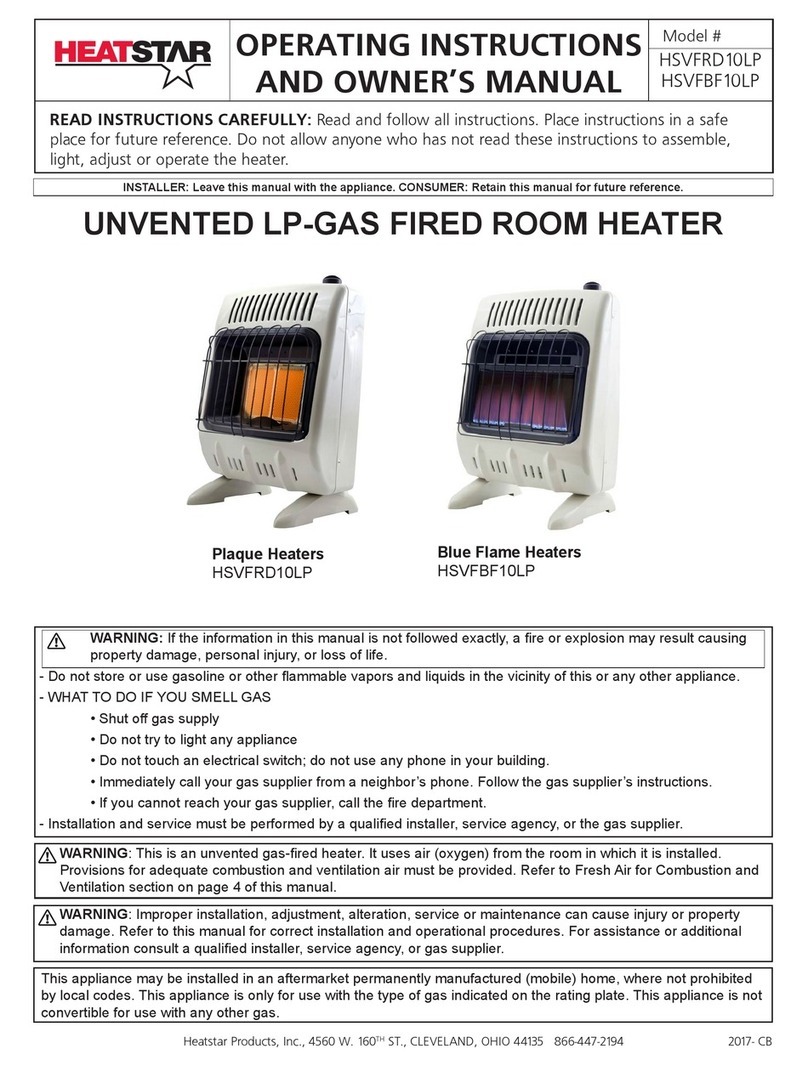
HeatStar
HeatStar HSVFRD10LP Assembly instructions
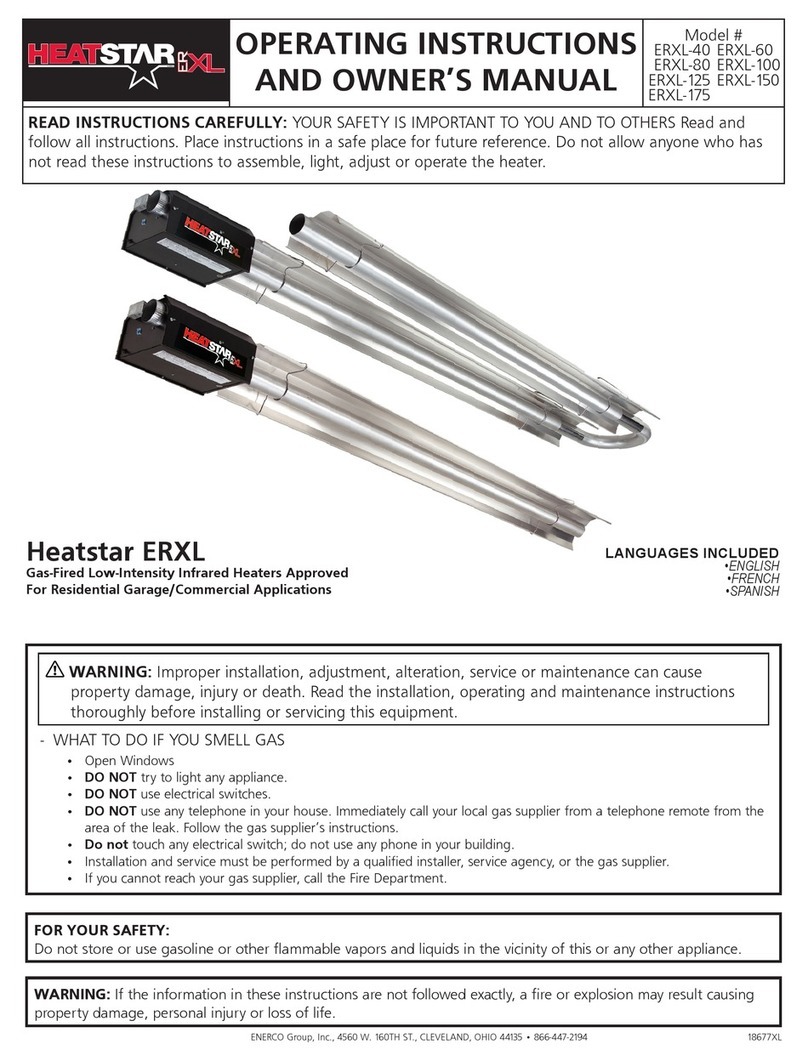
HeatStar
HeatStar ERXL Series User manual

HeatStar
HeatStar HSVFR10LPT Assembly instructions

HeatStar
HeatStar HS50K Assembly instructions

HeatStar
HeatStar HSVFRD20LPBTS Assembly instructions

HeatStar
HeatStar HSVFR20TB NG Assembly instructions
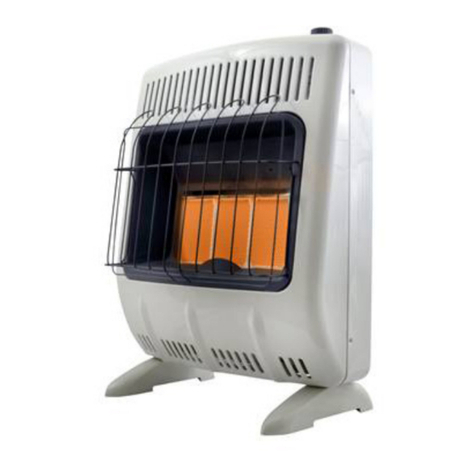
HeatStar
HeatStar HSSVFRD20NGBT Assembly instructions
Popular Gas Heater manuals by other brands

Stanley
Stanley ST-11T-CPH-E User's manual and operating instructions
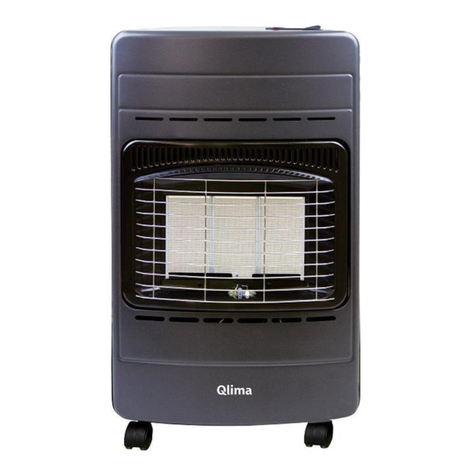
Qlima
Qlima GH 142 RV Directions for use
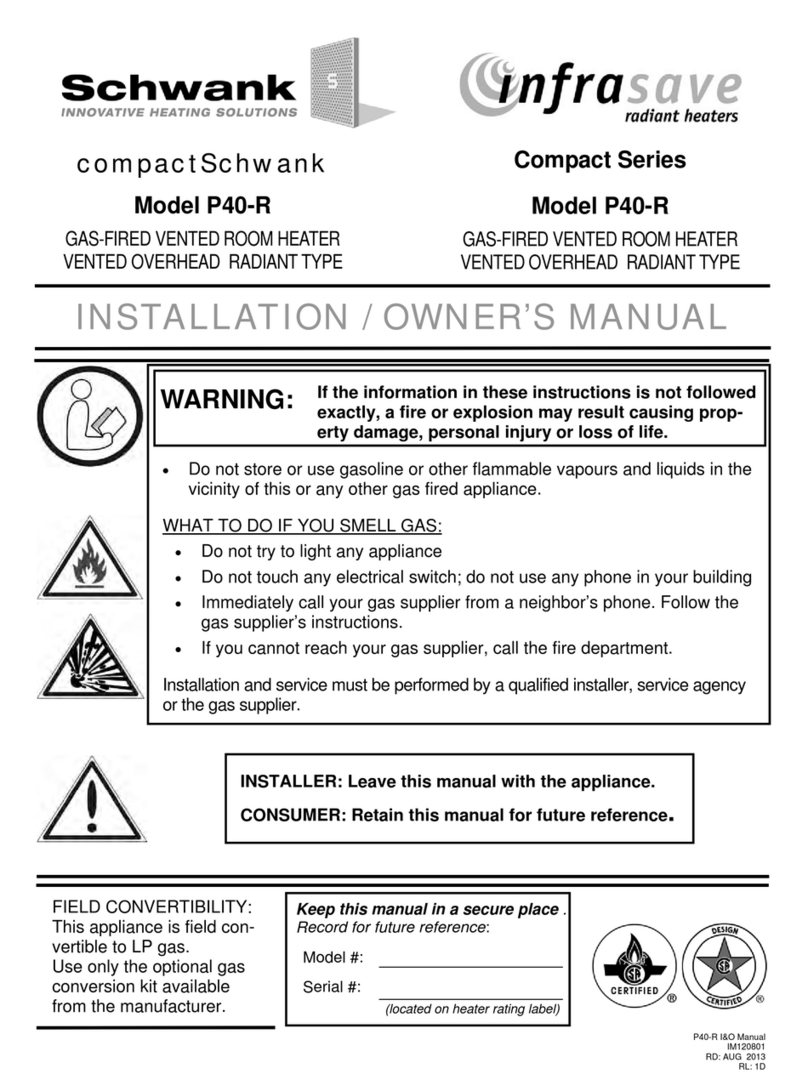
Schwank
Schwank compactSchwank P40-R Installation & owner's manual
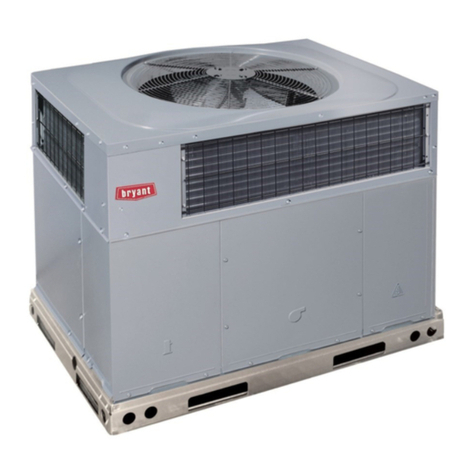
Bryant
Bryant 574B user manual

Toolland
Toolland FT92N instructions
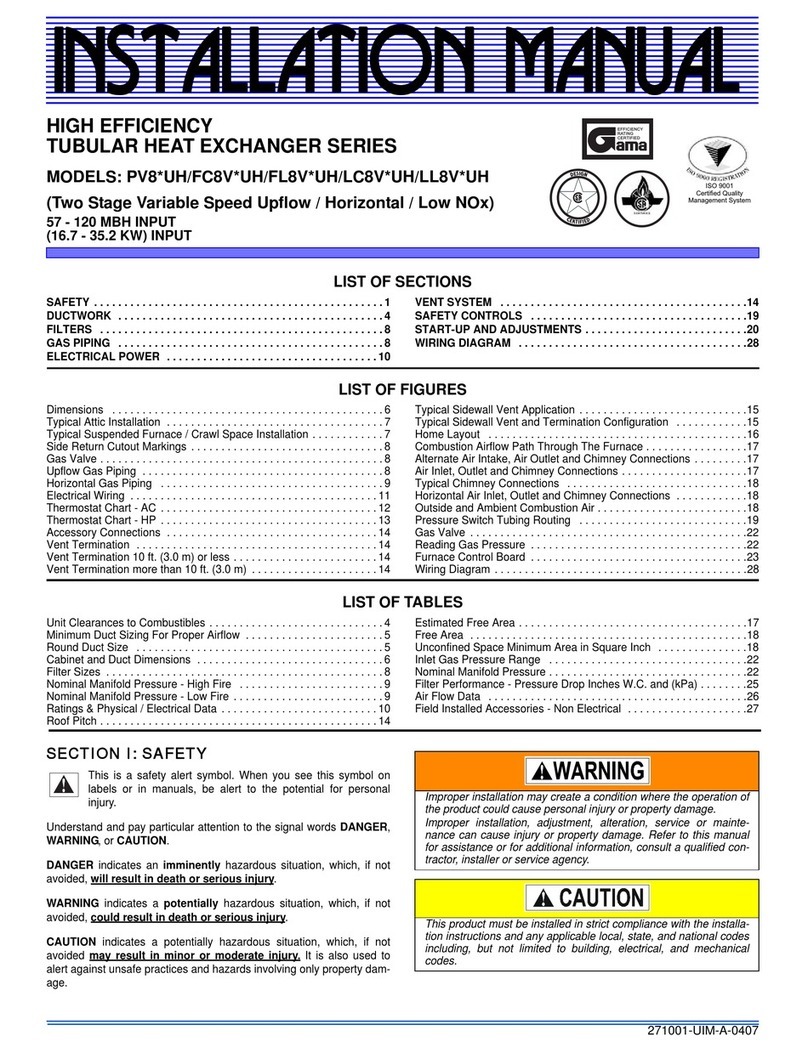
Unitary products group
Unitary products group PV8*UH installation manual

